Photo/Video | ||
| ||
Simulation at

- Program level/Part operation level
- Select the desired option to perform material removal simulation at either
Manufacturing Program or Part Operation level. Depending on the selected level, simulation begins either from the start
of the Manufacturing Program or from the start of the Part Operation .
Note: Best performance is obtained with program level.
 By default,
the Program level option is selected.
By default,
the Program level option is selected.
![]()
Video
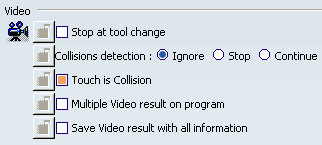
- Stop at tool change
- When selected, stops the Video
simulation each time a Tool Change is encountered in the program.
 By default,
this check box is not selected.
By default,
this check box is not selected. - Collision detection
- Select the desired Collisions detection option to:
- Ignore collisions during the Video simulation
- Stop the Video simulation at the first collision
- Continuethe Video simulation even when collisions are detected. In this case, you can consult the list of collisions at any time during the simulation.
Note: Best performance is obtained when collisions are ignored.
 By default,
the Ignore option is selected.
By default,
the Ignore option is selected. - Touch is collision
- When selected, detects collisions of type touch
(or contact).
 By default,
this check box is selected.
By default,
this check box is selected. - Multiple Video result on program
- When selected, stores video results on more than one operation in the program.
 By default,
this check box is not selected.
By default,
this check box is not selected. - Save Video result with all information
- When selected, saves a video result with geometrical information and all extra information such as collisions, cut information, material etc.
 By default,
this check box is not selected.
By default,
this check box is not selected.
![]()
Photo

- Fault box
- Select the desired Fault box type for examining remaining
material or gouges:
- Transparent: to display a transparent bounding box
- Wireframe: to display a wireframe bounding box
- None: if no bounding box is required.
 By default,
the Wireframe option is selected.
By default,
the Wireframe option is selected. - Compute all information at picked point
- When selected, computes all information at the picked point.
Note: Best performance is obtained when:
- Fault box is set to None
- and the Compute all information at picked point check box is not selected.
 By default,
this check box is not selected.
By default,
this check box is not selected.
![]()
Performance
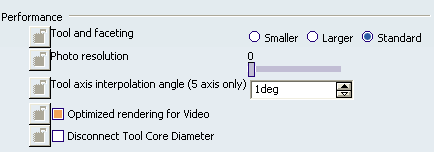
- Tool and faceting
- Lets you select the required method of tool faceting used in Video simulation:
- The number of facets for a tool representation is determined by the chord deviation that is set for the tool diameter (0.005% of the tool diameter).
- Smaller: The picture shows a rough approximation of a tool
with six facets.
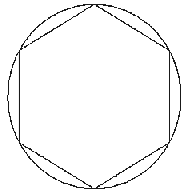
This is the most accurate method for the Arc through Three Points command.Note: The chord deviation is always inside the actual circle, and the points are always on the circle (accurate).
- Standard: The picture shows a rough approximation of a tool
with six facets.
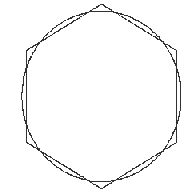
This is the best method for material removal simulation. However, it is not suitable for the Arc through Three Points command.Note: The chord deviation is partly inside and partly outside the actual circle, and the points are not always on the circle.
- Larger: The picture shows a rough approximation of a tool
with six facets.
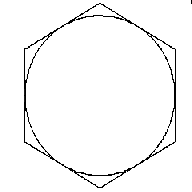
This is not suitable for the Arc through Three Points command. However, it can be useful for gouge detection.Note: The chord deviation is outside the actual circle, and that the points are not on the circle.
 By default,
the Standard option is selected.
By default,
the Standard option is selected. - Photo resolution
- Lets you set the photo resolution.
- Best performance is obtained when the resolution is set to 0. In this case, a detailed simulation of a portion of the part can be obtained using the Closeup command.
- Increasing the resolution improves machining accuracy and gives a very detailed simulation. However, this requires increased memory and computation time.
 By default,
this resolution is set to 0.
By default,
this resolution is set to 0. - Tool axis interpolation angle (5-axis only)
- Lets you specify the maximum angle that the tool axis is allowed to vary between
two consecutive points.
- Best performance is obtained for an angle of 10 degrees.
- Decreasing the angle improves the precision of the simulation. However, this requires increased memory and computation time.
 By default,
this angle is set to 1 degree.
By default,
this angle is set to 1 degree. - Optimized rendering for Video
- When selected, optimizes the rendering and improves Video simulation performance:
- The simulation engine displays the tool used for simulation.
- The cutting is in green, blue color (depending on the color setting) and the non-cutting part is grey.
- The tool in the simulation engine is defined by the sketches found in the user representation.
- If fillets are added after on the shaft, they are not taken into account.
- If you need radii, you need to put them on the sketch definition.
- When cleared, gives more realistic colors with a slightly degraded
performance:
- The simulation engine computes the simulation with the previous described tool (without radius) but shows on each movement the representation of the tool (as in replay). You can see the colors and the fillets (but they are not taken into account for material removal).
- Supports milling and drilling operations.
 By default,
this check box is selected.
By default,
this check box is selected.- When selected, optimizes the rendering and improves Video simulation performance:
- Disconnect Tool Core Diameter
- When selected, disconnects the tool core diameter.
 By default,
this check box is not selected.
By default,
this check box is not selected.
![]()
Color of Tool and Machined Area
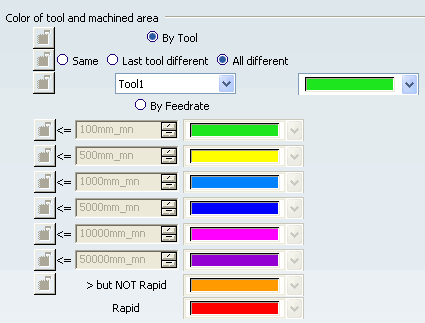
- By Tool
- When selected, associates a color to each tool and lets you set the tool (and associated machined area) color to be the same as or
different from the last tool, or have different colors for all tools.
Note: Best performance is obtained with same colored tools.
 By default,
By Tool and All different are selected.
By default,
By Tool and All different are selected. - By Feedrate
- When selected, proposes six specific values of feedrate.
- You can modify these feedrate values.
- You can choose a color for each feedrate interval. For example:
- for Feedrate <= 100mm_mn, the color is green.
- for Feedrate <= 500mm_mn, color is yellow.
 By default,
By Feedrate is not selected.
By default,
By Feedrate is not selected.
![]()
Other Color

- Tool holders/Parts/Fixtures
- Let you assign colors to tool holders, parts, and fixtures from the lists.
![]()
Positioning Move

- Maximum tool axis variation
- Lets you set the maximum tool axis variation allowed
between the end point of an operation and the start point of the next operation.
Note: If the tool axis varies by an amount greater than the specified value, the tool is positioned at the start of the following operation.
 By default,
this angle is set to 1 degree.
By default,
this angle is set to 1 degree.